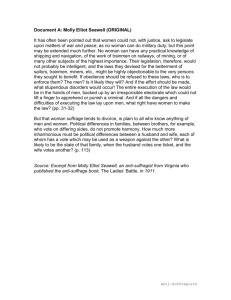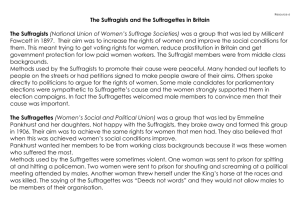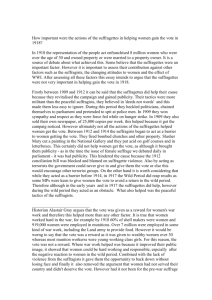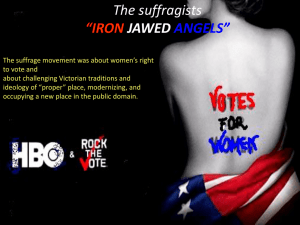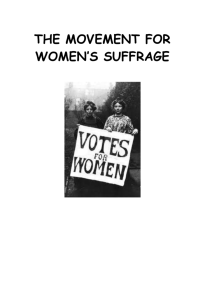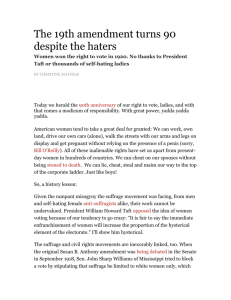Key Issue: HOW DID HITLER CHANGE GERMANY FROM A
advertisement
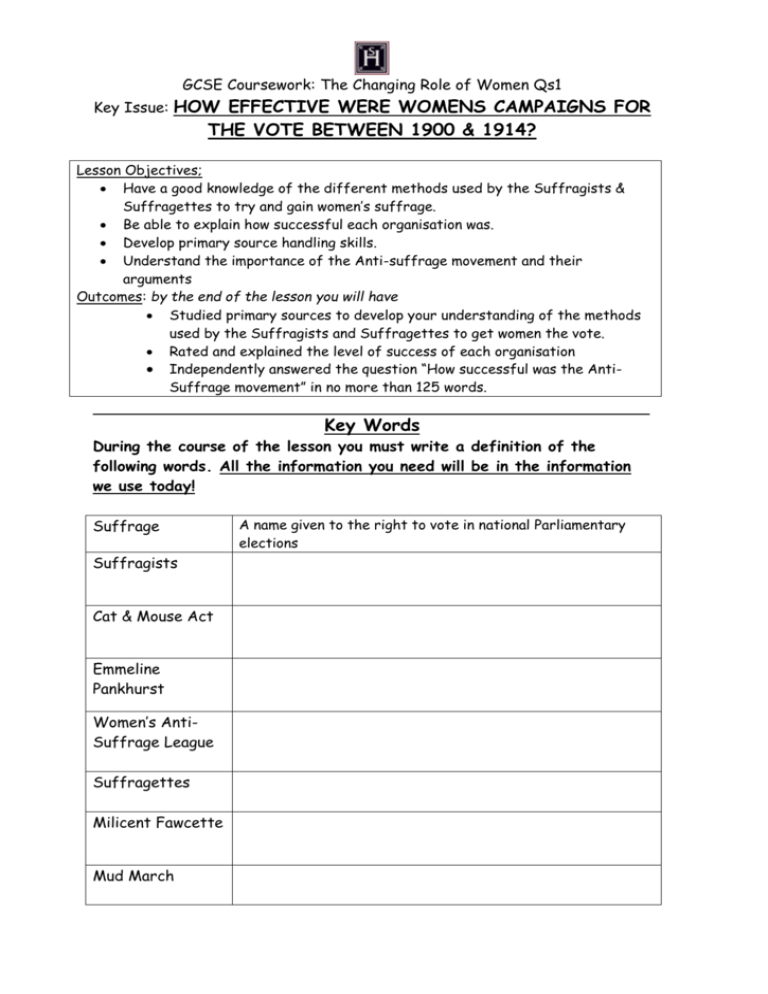
GCSE Coursework: The Changing Role of Women Qs1 Key Issue: HOW EFFECTIVE WERE WOMENS CAMPAIGNS FOR THE VOTE BETWEEN 1900 & 1914? Lesson Objectives; Have a good knowledge of the different methods used by the Suffragists & Suffragettes to try and gain women’s suffrage. Be able to explain how successful each organisation was. Develop primary source handling skills. Understand the importance of the Anti-suffrage movement and their arguments Outcomes: by the end of the lesson you will have Studied primary sources to develop your understanding of the methods used by the Suffragists and Suffragettes to get women the vote. Rated and explained the level of success of each organisation Independently answered the question “How successful was the AntiSuffrage movement” in no more than 125 words. Key Words During the course of the lesson you must write a definition of the following words. All the information you need will be in the information we use today! Suffrage Suffragists Cat & Mouse Act Emmeline Pankhurst Women’s AntiSuffrage League Suffragettes Milicent Fawcette Mud March A name given to the right to vote in national Parliamentary elections GCSE Coursework: The Changing Role of Women Qs1 The Status of Women in 1900 Task: Study the source below Source A “Failure to recognise that man is master, and why, is at the root of the suffrage movement. Suffragettes ignore man’s superior strength and they ignore the fact that government runs on force. They ignore man’s superior mind, and so think that they can think as well. They ignore man’s superior money-earning capacity, so ignore the power of the purse.” An extract from the Book, ‘The Case Against Woman Suffrage’, 1913 Why does source A say that women should not have the right to vote? What is source B’s view on Women getting the vote? Do you find this surprising? Explain your answer The Campaign for Women’s Suffrage A background As the 19th century progressed, women were given a number of civil rights, including the right to vote in local elections (see your notes for more examples). But by 1900 they had still not been given the right to vote in Parliamentary elections. The Campaign begins In 1866, a number of women took a petition, signed by 1,500 women and asking for the vote, to Parliament, where two of the handful of pro-vote MPs presented it. In 1897, Millicent Fawcett brought the various women’s societies together into the National Union of Women’s Suffrage Societies (NUWSS). These ‘Suffragists’ as GCSE Coursework: The Changing Role of Women Qs1 they were called, campaigned peacefully for the vote. Although the number of prosuffrage MPs in the House of Commons grew, the Suffragists made little progress. In 1903, therefore, Emmeline Pankhurst formed the Women’s Social and Political Union (WSPU). The ‘Suffragettes’, as they can to be called, were much more aggressive in their campaign and saw the struggle for the vote as a war - women against men. Activity) Get into groups of no more than four Your envelope should contain - - sources and 2 headings, ‘Suffragist Methods’ & ‘Suffragette Methods’ Spread out the sources on your desk. Each source represents a method used to try and win women the vote. 1st – You must decide what the methods were 2nd – You must put the method under the group you think used it. 3rd – In your exercise book complete 2 spider diagrams Methods used by the Suffragists Methods used by the Suffragettes Read the handout and Pp143 & 144 of the text book. Make sure that you have all the different methods used by the Suffragists and Suffragettes on your spider diagram. Fill in any examples, details of each method used. Task: Complete the table below in pencil. On a scale of 1-10 rate how successful you think the Suffragists and Suffragettes methods of winning the vote were. Explain your choices. Group Suffragists Suffragettes Level of success on 10 Explanation for the score GCSE Coursework: The Changing Role of Women Qs1 Task: Now study the source on the board. Fill in the table above in pen. The Campaign Against Women’s Suffrage Task: Study the text and the Sources below. Many men opposed women’s suffrage. Most believed that a womens place was at home and that women should not get involved in the messy world of politics. In 1875, a Committee for Maintaining the Integrity of the Franchise had been formed in Parliament. This organisation aimed to make sure that women were not given the right to vote. It had a lot of power because it was made up largely of MPs. The Anti-Suffragists It was not just men who were against women’s suffrage, many women opposed it too, for a variety of different reasons (see sources below). Many people simply believed that the cause of women’s suffrage was wrong. In 1908 Mrs Humphrey ward, a writer and social worker, started the Women’s Anti-Suffrage League. She believed that a woman’s place was in the home and that everything that she did should be towards making her home a better place. Any spare time and energy should be spent helping those less fortunate than herself and not in fighting for her ‘rights’. In 1911 the Women’s Anti-Suffrage League merged with the Men’s League for Opposing Women’s Suffrage to form the National League for Opposing Women’s Suffrage Source C Sources Women, as mother, sweetheart, inspirer and friend, man accepts and welcomes. But once she begins to invade his area, to do his work – then his jealousy will burst into flame, and everywhere there will be great problems Anti-Suffrage Review In this cartoon by Bernard Partridge the sensible woman is saying to the Suffragette: ‘Help our cause? You’re its worst enemy.’ In this 1909 cartoon, the suffragette lists all the trouble she has caused, and then wonders why she still hasn’t got the vote. Source D “I regard women as superior and I don’t like to see them trying to become men’s equal” Miss Violet Markham, speaking in October 1910 GCSE Coursework: The Changing Role of Women Qs1 IMPORTANT: By 1914 women had not gained the right to vote in government elections. MPs had voted against it in 1912. Task: Using the information you have studied on the Anti-Suffrage movement answer the following Qs in no more than 125 words in your exercise book: How successful was the Anti-Suffrage Movement? Fully explain your answer You must include; Details on what methods the Anti-Suffrage movement used. Who supported them Why you think they were successful or not

